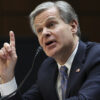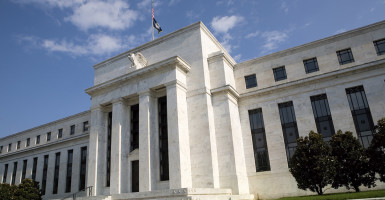The Federal Reserve has injected trillions into the banking system since the 2008 crisis, and we’re still stuck in a low-growth economy. Yet rather than question the Fed’s overall mission and effectiveness, we’ve become obsessed with interest rates:
Did the Fed make rates too low? Should it raise rates now or wait till December? If it raises rates now, what will happen?
Last week, the Fed did nothing to their rate target, and pretty much nothing happened. So before we get to the next Fed meeting hysteria fest, let’s address the big issues.
We don’t really have market-based interest rates, and that won’t change if the Fed raises its target 0.25 percent next month or next year. Our financial sector doesn’t currently function like an efficient private market because it’s not an efficient private market.
The federal government currently backs up to 60 % of the financial sector.
If we want normalize things and get back to a solidly growing economy, we need to reverse this trend. And we can’t do that unless we stop the Fed from being able to undertake the kinds of distortive policies it implemented during the 2008 meltdown.
Some of the most troubling Fed actions were the so-called emergency loans authorized by Section 13(3) of the Federal Reserve Act. Between December 2007 and July 2010, the Fed lent more than $16 trillion via what it called broad-based emergency lending programs.
Dodd-Frank was supposed to curb the Fed’s 13(3) authority, but it really didn’t. So it’s a great sign that Senators Elizabeth Warren (D-Mass.) and David Vitter (R-La.) have introduced a bill to restrict the Fed’s emergency lending.
Their approach would be an improvement over what Dodd-Frank did. It addresses (among others) two of the weakest parts of the Fed’s post-Dodd-Frank emergency authority: solvency and subsidies.
The idea is to restrict the Fed to lending only to solvent firms, and to prevent it from lending at below-market interest rates.
The bill also tries to ensure that the Fed won’t design emergency lending programs to save one or two individual firms. The idea here is to better focus the Fed on addressing system-wide liquidity issues.
Collectively, these ideas aim to align the Fed’s emergency lending with the classic prescription for a lender of last resort.
To follow those guidelines, the central bank should lend only to solvent firms at a high rate of interest, with no obligation to save individual firms. But there are a few major problems with this approach.
First, if the Fed is restricted to making loans only to solvent firms, why do we need the Fed to make these loans?
The truth is that we don’t need a government lender of last resort if all they ever do is lend to solvent firms. We have these things called banks.
The counter-argument is that banks are afraid to lend during a crisis, and that they often hoard cash during such times. These claims still do not justify a government lender of last resort.
If banks don’t want to make loans even though they’re flush with the money to do so, we simply don’t have a liquidity crisis. If they think the firms that need loans are insolvent, there’s no reason to trust that the Fed knows differently. And critics who argue these cash-hoarding banks need emergency loans may want to re-examine their logic.
If, on the other hand, the banks are hoarding cash to meet regulatory requirements, then those rules need to be fixed. Either way, this situation is not a liquidity problem that can be solved with emergency loans that adhere to the classic prescription.
There’s also a core problem with forcing the Fed, or anyone else, to “certify” that a bank is solvent. There is no objective “bright line” that delineates the difference between insolvency and illiquidity.
It’s often difficult to tell for sure whether a bank is merely illiquid or insolvent, a problem that’s only magnified during a crisis. And before we know for certain, a case can always be made that a bank will become insolvent unless it receives additional liquidity.
It’s impossible to prove or disprove such a proposition ex ante. Though not obvious at the time, it may become obvious later on that a bank was insolvent. And if it is truly healthy, a bank should be able to withstand a temporary liquidity problem.
At best, regulators have the same level of difficulty as bankers when trying to gauge solvency. At worst, regulators have an incentive to label difficulties as liquidity problems, because the failure of a regulated bank suggests regulators failed to do their job.
And a lender of last resort that never makes emergency loans has a much harder time justifying its existence.
On the other hand, when everyone expects a central bank to make these last-resort loans, it creates a moral hazard. That is, we end up with more risky loans because financial firms—and their creditors—expect access to emergency loans.
During the 2008 crisis, a related moral hazard problem surfaced with Lehman Brothers. When the Fed assisted Bear Stearns, it created the expectation among other financial firms that the Fed would help them.
In particular, Lehman did not raise additional capital because they felt certain that the Fed would provide assistance. But the Fed didn’t, thus creating additional uncertainty and, arguably, worsening the crisis.
Either way, eliminating the expectation of emergency loans would reduce the likelihood of these types of problems—and of a future crisis—by reducing risky behavior. (Even if that risky behavior is waiting for a lifeline from the Fed).
Another big problem is the Fed’s track record in handling last-resort lending. Throughout its entire history, the Fed’s lending policies have pushed the limits of whatever restrictions were in place.
These loans, even aside from formal 13(3) loans, have regularly come under fire for sustaining insolvent institutions. That’s hardly a surprise, given that the natural tendency for a central bank will always be to make loans in the name of preventing a calamity.
None of these arguments against emergency lending is new. Many others have previous articulated the reasons to end the Fed’s emergency lending authority and to focus its mission, instead, on providing system-wide liquidity.
In fact, in those few historical cases where the Fed seems to have staved off a crisis, that’s what it did—it temporarily expanded its open-market operations instead of providing emergency loans.
It’s very encouraging that there’s bipartisan interest in ending too-big-to-fail by reforming the Federal Reserve. There are a host of reforms that would leave us with a better central bank, one that makes bailouts via the Fed virtually impossible and financial crises less likely.
The best reform would be to eliminate the Fed’s emergency lending authority. Congress could then implement the following changes:
- Close the discount window and scrap the primary dealer system. Instead, allow all highly rated banks to participate in open market operations—perhaps through a modified term auction facility—so that liquidity provision is enhanced.
- Require the Fed to operate under a transparent, rules-based regime so that ad hoc policies are a thing of the past.
- Transfer the Fed’s regulatory authority to either the FDIC or the OCC so that the Fed’s monetary policy decisions can’t be influenced by regulatory failures.
A great way to get these ideas in front of the general public, as well as members of Congress that don’t regularly focus on these issues, is to have a formal monetary commission.
Financial markets have changed quite a bit since the Fed was founded. Our central bank today barely resembles the institution that Congress created in 1913. Implementing the reforms outlined here will do much more to normalize financial markets than whatever the Fed decides to do with its rate target in the next few months.
Originally published in Forbes.

























